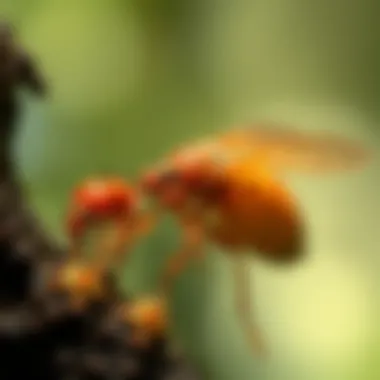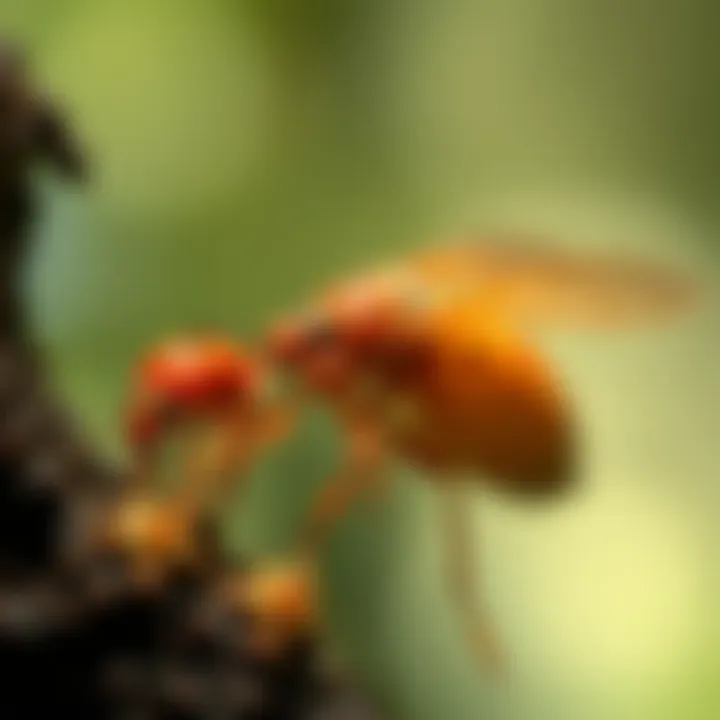Natural Aphid Solutions for Sustainable Forestry Practices


Intro
Aphids, those tiny sap-sucking insects, can wreak havoc on the health of trees and overall woodland ecosystems. As the pursuit for sustainable forestry practices intensifies, understanding how to effectively manage these pest populations without resorting to synthetic chemicals is crucial. In this article, we will explore natural aphid treatments that align with sustainable woodland care, providing forestry professionals and environmental advocates with actionable insights.
By delving deep into various strategies—such as fostering beneficial insect populations, creating homemade remedies, and adopting proactive cultural practices—we offer a comprehensive guide aimed at improving the health of forests while preserving their ecological integrity. This approach not only enhances forest resilience but also supports the myriad of flora and fauna that call it home.
Engaging with natural pest management techniques is not simply a trendy move; it’s vital for the long-term stewardship of our woodland resources. Together, we will navigate through the complex world of sustainable forestry and explore how these methods can make a meaningful difference in managing aphid infestations.
Understanding Forestry Practices
Forestry practices serve as the backbone of sustainable land management. They encompass a variety of approaches designed to balance human needs with the health of forest ecosystems.
Types of Forestry Practices
- Conventional Forestry: This method often prioritizes timber production, sometimes at the expense of ecological balance. Chemical treatments may be employed, which could harm non-target species.
- Sustainable Forestry: This approach seeks to meet current demands without compromising the health of future forests. It incorporates natural pest management methods, integrated pest management, and conservation techniques.
- Agroforestry: A mix of agriculture and forestry, where crops and trees coexist. This method enhances biodiversity and can deter pests like aphids through natural predation.
- Community Forestry: Involves local communities in managing forest resources. Their traditional knowledge can provide insights into more resilient, natural pest control measures.
Historical Context
Historically, our ancestors relied on intuition and observation to manage pest populations. It wasn’t until the mid-20th century that synthetic pesticides began to dominate pest management in forestry. As awareness about the impacts of these chemicals grew, so did the interest in more traditional, ecological methods. Today, the evolution of forestry practices emphasizes a return to these holistic techniques and recognizes the interconnection between all forest inhabitants.
Principles of Woodland Stewardship
Effective woodland stewardship is centered around preserving interdependence in the ecosystem. Recognizing that every move we make in forest management has consequences is critical in developing a sustainable approach.
Conservation Techniques
Incorporating practices that support biodiversity can significantly help control aphid populations naturally:
- Promote native plant species: They provide food and habitat for aphid predators.
- Implement cover cropping: This protects soil health and attracts beneficial insects to control pests.
- Create hedgerows: These serve both as barriers and habitats for natural pest controllers, thus contributing to improved ecological balance.
Managing Forest Resources
To manage resources sustainably, it’s necessary to focus on:
- Resource monitoring: Regular assessments help understand forest dynamics and aphid populations.
- Adaptive management: Flexibility in your approach allows adjustments based on monitoring findings and ecological changes.
- Education and training: Empowering stakeholders with knowledge about natural aphid treatments fosters a culture of stewardship over time.
Sustainable Forest Management
Sustainable forest management (SFM) involves policies and practices that ensure forest ecosystems are maintained for future generations.
Certification Standards
Assessment and certification systems like FSC (Forest Stewardship Council) and PEFC (Programme for the Endorsement of Forest Certification) help ensure that forestry practices are environmentally responsible. Certifying bodies encourage the use of integrated pest management, which includes natural aphid control methods.
Economic Benefits of Sustainability
Investing in sustainable practices yields several long-term economic benefits:
- Enhanced forest productivity, leading to higher quality timber and consistent income.
- Reduced pesticide costs, as natural treatments can often be more cost-effective than synthetic options.
- Increased consumer demand for sustainably produced goods, which can lead to premium pricing for certified products.
Using those practices not only supports the environment but also promotes a bustling economy in the forest products sector.
"The crux of sustainable forestry lies in recognizing that every tree cut down, every shrub pruned, and every aphid managed impacts the ecosystem profoundly."
Understanding Aphids in Forest Ecosystems
Aphids are often misunderstood creatures in the grand tapestry of forest ecosystems. While numerous species might seem bothersome, their ecological roles are significant. Recognizing why they matter in these environments can shed light on effective management practices for forest health.
The Role of Aphids in the Food Web
Aphids serve as an essential link in the food web. They are primary consumers that feed on the sap of trees and plants, which then makes them an attractive food source for a variety of predators, including ladybugs, lacewings, and birds. By providing nourishment to these beneficial insects, aphids indirectly bolster the complex interactions within their habitat. This means they help sustain biodiversity and contribute to the stability of the ecosystem.
Additionally, their high reproductive rate means that they can quickly increase their populations, making them a key food source during times when other food is scarce. This seasonal dynamic highlights their importance in maintaining a balanced food chain.
"A healthy forest thrives on its biodiversity, and every player in the food web has its role to fulfill."
Understanding these predator-prey relationships emphasizes the value of maintaining a natural population of aphids. When pest management practices focus solely on eradication, it can throw the balance out of whack, leading to larger ecological consequences.
Common Species of Aphids Affecting Forestry
Not all aphids are the same. Different species have varying impacts on forestry and understanding these distinctions is crucial for managing their populations effectively. Among the most common aphid species that target forests are:
- Green Peach Aphid: Typically found on many plant types, this species can affect both agricultural and wild plants, making it a notorious pest.
- Black Cherry Aphid: Specific to cherry species, this aphid can weaken trees, leaving them susceptible to diseases.
- Cotton Aphid: This one can affect a range of crops, showcasing its adaptability and resilience.
Each of these species has unique behaviors and infestation tendencies, requiring tailored approaches in management. For instance, the Green Peach Aphid's proclivity for warm weather can inform when and how to monitor for heightened infestations.
In summary, understanding aphids goes beyond just knowing they exist. It's about recognizing their role within the local forest ecosystem and tailoring strategies that not only address infestations but also value the ecological balance they contribute to.


Signs of Aphid Infestation
Understanding how to identify aphid infestations is paramount for effective management in forestry. Aphids, while minor in size, can cause significant harm to plants and trees, disrupting the delicate balance within forest ecosystems. Failing to recognize the signs of aphids may lead to unchecked populations, resulting in broader environmental impact and loss of biodiversity. Recognizing the symptoms early can provide the opportunity for timely intervention, allowing forestry professionals to protect their ecosystems effectively.
Identifying Damage to Trees and Plants
Detecting aphid damage on trees and plants involves scrutinizing changes that occur subtly over time. Aphids are notorious for their sap-sucking habits, which can lead to several telltale signs of damage, including:
- Leaf Curling: One common indicator is the curling of leaves. Aphids feed on the sap, causing leaves to distort and curl, which hinders photosynthesis and can stunt growth.
- Yellowing Leaves: As trees and plants lose vital nutrients due to aphid feeding, leaves may yellow, indicating stress. This condition no longer supports optimal growth, setting the stage for further complications.
- Stunted Growth: Infestations can also lead to noticeable stunted growth. Trees that are regularly blasted by aphids can begin to appear smaller or develop fewer leaves than healthier counterparts.
Beyond aesthetic concerns, these damages suggest a deeper disruption in health. It’s crucial to document and monitor affected areas meticulously, as untreated infestations can lead to mortality of weakened trees.
Visual Indicators of Aphid Presence
Aphids might be small, but several visual cues can help identify their presence before they escalate into serious issues. Look for the following signs:
- Sticky Residue (Honeydew): One of the hallmark signs of aphids is the sticky substance they excrete, commonly referred to as "honeydew." This sugary syrup can attract other pests and lead to sooty mold, exacerbating the problem.
- Presence of Ants: Often, ants are found near aphid-infested plants. They are attracted by the honeydew and may even protect aphids from their natural predators, making thier presence a red flag for possible infestations.
- Mold Growth: If you notice a black, sooty mold on the foliage, it's likely a sign of aphids. This mold thrives on honeydew and can further complicate plant health.
Visual inspections should be frequent and thorough. Early detection through recognizing these signs can save substantial time and energy in management efforts, promoting healthier ecosystems.
Maintaining awareness of these signs not only fosters timely interventions but also contributes to a more holistic understanding of your forest's health. By weaving these observations into a regular monitoring routine, forestry professionals can develop better strategies for aphid control and overall ecosystem management.
Ecological Impact of Aphids
Aphids may seem like a small blip on the radar of forest ecosystems, yet their ecological impact cannot be overstated. They play a complex role in the health and functionality of these environments. Understanding their effects goes a long way toward implementing effective natural treatments for aphid management.
Effects on Forest Health and Biodiversity
Aphids thrive in diverse woodland ecosystems. While they are often viewed as pests, their role in the ecosystem is nuanced. First, aphids serve as a food source for various predators, including ladybugs, lacewings, and birds. These creatures rely on aphids as a key component of their diet, thus emphasizing the interconnectedness of forest life. An imbalance in aphid populations can ripple through the food web, potentially leading to a decline in predator species—a critical link in maintaining biodiversity.
Second, aphids can influence tree health, both positively and negatively. By feeding on plant sap, they can weaken trees, making them more susceptible to diseases and other pests. However, in milder infestations, the stress they impart may stimulate plants to enhance their own defenses, leading to an increase in secondary metabolites that make the plants less palatable to other herbivores.
Lastly, aphids excrete honeydew, a sugary substance that fosters the growth of sooty mold, which can affect photosynthesis of plants. While this can hamper plant growth, it also creates a habitat for fungi and serves as a food source for other insects, showcasing the duality of apholds' ecological relationships.
"The balance of nature is fragile; every creature, from the minutest aphid to the grandest of trees, plays its part in the intricate ballet of the forest ecosystem."
Interplay with Other Insect Species
Aphids don't exist in isolation. Their relationships with other insect species are dynamic and complex. On one level, they can be both beneficial and detrimental. For instance, the presence of aphids can attract parasitic wasps, which lay eggs within them. This not only helps control aphid populations but also enriches the broader ecosystem by promoting diverse insect interactions.
However, this interaction can have consequences; in some scenarios, aphids may attract ants, which farm them much like livestock. Ants protect aphids from predators, fostering conditions that can lead to severe infestations, thus creating a challenge for forestry health.
Furthermore, some aphid species can transmit plant viruses between trees, leading to widespread plant disease. This transmission has a cascading effect on forest health, potentially leading to decreased biodiversity as weakened trees are less able to compete for resources.
Cultural Control Methods
Cultural control methods play an essential role in managing aphid populations in sustainable forestry. These strategies are about nurturing the ecosystem rather than fighting it. The philosophy behind cultural controls springs from the idea that a healthy environment is less susceptible to pest infestations, including aphids. By focusing on building plant resilience and creating a diverse habitat, we can foster a self-regulating system that keeps pests in check.
Promoting Plant Health Through Diversity
One of the most effective ways to promote plant health is through biodiversity. Biodiversity is like a sturdy bridge; more supports mean less risk of collapse. In the context of forestry, encouraging a variety of tree and plant species can prevent aphids from establishing themselves. Mixed species planting can confuse aphids, as they often prefer certain species over others. If a specific tree type is affected, surrounding plants can still thrive, maintaining the overall health of the ecosystem.
Moreover, diverse planting not only attracts beneficial insects like ladybugs and lacewings, but also fosters microbial communities in the soil that fortify plant roots. This synergy builds a system that can better withstand pest pressures. Here’s how planting diversity can be advantageous:
- Attracting Predators: Different plants draw various predators that can keep aphid numbers low.
- Nutrient Availability: A mix of plants may enhance nutrient cycling in the soil, contributing to healthier plants.
- Risk Minimization: Diseased or pest-infested species don’t take out the whole ecosystem when there are many plant kinds.
In summary, promoting plant diversity is not merely an ecological luxury; it is a practical approach that aids in combating aphid infestations more effectively.
Crop Rotation and Companion Planting
Crop rotation and companion planting are tried-and-true techniques that embody the principles of cultural control. The process of rotating crops disrupts the lifecycle of aphids and other pests. When you change the types of plants grown in a particular area, it makes it harder for pests that thrive on specific plants to settle in.
For instance, if you follow a yearly rotation of legumes in one season and then switch to brassicas the next, aphids that prefer one type won’t find their favorite buffet available to them the following year. This method reduces their population over time, essentially starves them out of the food source they’ve come to rely on.
Companion planting further complements this approach. By planting certain crops together that can benefit from each other, you can create a natural habitat that deters pests.
- Examples:
- Marigolds are known to deter aphids and can be planted among vegetables.
- Rosemary can protect nearby beans from aphids and also enhance the flavor of the beans.
When implemented effectively, these practices form a sort of agricultural symbiosis, effectively managing pests like aphids without the need for synthetic chemicals. By fostering smarter planting strategies, we contribute to a robust ecosystem that supports both forestry needs and the delicate balance of nature.
Biological Controls
Biological control methods represent a cornerstone of sustainable forest management. Fostering natural systems rather than solely relying on chemical interventions, these approaches leverage the inherent checks and balances present in any ecosystem. They not only shield trees and plants from aphids but promote overall health and biodiversity in forest ecosystems. When employed effectively, biological controls can reduce aphid populations through the predation of beneficial organisms, thus minimizing reliance on synthetic pesticides and ensuring greater ecological balance.
Key Aspects of Biological Controls:


- Ecosystem Resilience: By utilizing naturally occurring predators or parasites, forests can maintain balance without the disruptions that synthetic chemicals impose.
- Safety for Non-target Species: Many biological methods are selective, meaning they can control aphid populations without harming beneficial insects or other wildlife.
- Reinforcement of Natural Processes: These mechanisms tend to support soil and plant health, thus fostering a resiliency that combats future infestations beyond the immediate issue at hand.
Integrating biological controls into management strategy requires careful planning and monitoring. Seasonality, local biodiversity, and the presence of desirable versus harmful insects all fall into play. It's essential to tailor biological strategies to specific environments, ensuring that introduced predators won’t disrupt existing ecological frameworks.
Utilizing Beneficial Insects
One of the most effective biological control strategies involves the promotion of beneficial insects, such as ladybugs, lacewings, and parasitic wasps, which prey on aphids. These insects function as natural predators, effectively reducing aphid numbers in a way that is both efficient and environmentally sound.
Benefits of Beneficial Insects:
- Natural Predation: Ladybugs, for instance, can consume upwards of 50 aphids in a single day. Their voracious appetite can lead to rapid population control.
- Lifecycle Adaptation: Many beneficial predatory insects have life cycles that allow them to thrive alongside aphids, enhancing their population during peak aphid seasons.
- Minimal Intervention Needed: By establishing habitats that attract these insects—such as planting diverse flora or avoiding broad-spectrum pesticide applications—foresters can effectively harness their natural predatory behavior.
Considerations for Implementation:
- Species Integration: Understanding which beneficial insects are local to the area can greatly influence their effectiveness. Some species may not be suitable for specific environments.
- Habitat Creation: Incorporating flowers and grassy areas can support adult insect populations that are essential for successful predation.
- Continuous Monitoring: Regular assessments of both aphid and beneficial insect populations should be conducted to gauge effectiveness over time.
Microbial Solutions to Aphid Problems
Exploring microbial solutions as a means to control aphids presents an innovative angle within biological control. Beneficial microbes, such as certain species of fungi and bacteria, can effectively reduce aphid populations by targeting them directly, or by enhancing the health of the host plants they infest.
Fungal Pathogens:
- Entomopathogenic Fungi: These fungi attack insect pests, leading to their demise and effectively curbing aphid populations. Once introduced to the ecosystem, they can continue to propagate if conditions remain favorable.
- Sustainability: Fungal treatments often require less frequent application than conventional chemicals, thus promoting a healthier forest over time.
Bacterial Treatments:
- Bacillus thuringiensis (Bt): This bacterium produces proteins toxic to certain insect larvae, including aphids, when ingested. The specificity of Bt means that its application does not adversely affect non-target species.
- Soil Health Improvement: By employing bacteria that improve overall plant health and vigor, trees can better resist aphid attacks even before they become a significant issue.
Considerations for Use:
- Application Method: Timing and method of application are crucial. Fungal spores may require moisture to ensure effectiveness, while bacterial products need careful consideration regarding the timing of application relative to aphid life stages.
- Monitoring Efficacy: Evaluating the success of microbial applications is important. Foresters should monitor not just aphid populations but the broader ecological impacts on the soil and plant health.
Utilizing these biological controls not only addresses short-term aphid problems but aligns well with the broader goal of creating sustainable forest ecosystems. By integrating both beneficial insects and microbial solutions into forestry practices, professionals can cultivate a more resilient and healthy woodland.
Natural Remedies for Aphid Management
Natural remedies for aphid management play a crucial role in maintaining the health of forestry ecosystems. These methods not only address aphid populations effectively but also enhance the overall health of the forest. Avoiding synthetic chemicals is where the benefits truly shine. By incorporating natural techniques, forest managers can ensure a balanced habitat where other beneficial organisms can thrive too. Working hand in hand with nature, these remedies often yield sustainable outcomes that bolster both plant vitality and biodiversity.
Homemade Insecticidal Soaps
Homemade insecticidal soaps have carved a niche as a viable, eco-friendly option to combat aphids. These soaps work by suffocating the pests, disrupting their ability to breathe. Made with simple ingredients found in most households, the process of creating these soaps is both accessible and cost-effective. Ingredients such as pure liquid soap combined with water can create an effective formula when mixed in proper concentrations. It's like brewing your own potion to ward off tiny invaders.
Key points for consideration when using homemade insecticidal soaps:
- Concentration Matters: A concentration of about 2-3% soap is generally considered effective for aphid control. Too strong a concentration may harm the plants.
- Application Timing: Apply during cooler parts of the day to minimize potential damage to plants. This ensures that the soap remains on the aphids longer, increasing effectiveness.
- Thorough Coverage: It’s not enough to spray and pray. Coverage needs to be comprehensive, ensuring every inch of the infested plant is treated.
"An ounce of prevention is worth a pound of cure."
Doing regular checks on plants can, over time, keep infestations at bay.
Plant-Based Oils as Deterrents
Plant-based oils serve as an additional layer in the natural arsenal against aphids. Oils derived from neem or peppermint can act as barriers, making it difficult for aphids not only to feed but also to reproduce. When applied, these oils coat the leaves, disrupting the aphids' feeding patterns and creating an inhospitable environment for them.
Consider the following aspects when using plant-based oils:
- Type of Oil: Neem oil is often favored due to its pest-repelling properties and low toxicity to beneficial species. Other oils such as rosemary or clove oil also show promising results.
- Dilution is Key: Like homemade soaps, it’s important to dilute the oils before application to prevent plant damage. A typical ratio could be 1 to 2 tablespoons of oil per quart of water.
- Regular Reapplication: Oils can wash away in rain or irrigation, so consistent application is crucial for maintaining effectiveness.
By engaging in these methods, forestry professionals can significantly reduce the aphid populations, ensuring healthier trees and plants in their care. Enlisting nature’s help, rather than battling it, adheres to the principles of sustainable forestry management.
Preventative Strategies
In the realm of sustainable forestry, preventative strategies play a crucial role in maintaining healthy ecosystems and thwarting aphid infestations before they take root. Unlike reactive measures, which often involve dealing with the consequences of pest problems, proactive approaches can significantly reduce the likelihood and impact of these nuisances. By emphasizing prevention, forest managers can foster an environment where natural balances restore themselves, allowing both flora and fauna to thrive.
Key benefits of integrating preventative strategies into forestry practices include:
- Reduced Dependency on Chemicals: Opting for natural methods minimizes the need for synthetic pesticides, promoting overall ecosystem health.
- Enhanced Biodiversity: Encouraging diverse plant and animal life bolsters the natural defenses of an ecosystem against aphids and other pests.
- Long-lasting Solutions: Preventative measures often create a resilient forest environment, reducing the frequency of infestations.
While implementing effective preventative strategies, one must consider various elements such as plant selection, soil health, and continuous monitoring. Such facets intertwine to create a robust defense against possible aphid outbreaks.
Regular Monitoring and Assessment
To successfully prevent aphid infestations, regular monitoring and assessment of the forest ecosystem are vital. This process involves not only checking for the presence of aphids but also evaluating the overall health of the trees and surrounding plants. Understanding the health of individual species and their interactions in the ecosystem can help pinpoint vulnerabilities.
Forest managers can adopt specific practices for effective monitoring:
- Visual Inspections: Regularly check trees for unusual signs, including discoloration or wilting leaves, which may indicate stress due to aphid activity.
- Use of Traps: Implement sticky traps to gauge populations of aphids and their natural predators, offering insight into ecosystem dynamics.
- Soil Testing: Periodic soil assessments can reveal nutrient deficits that may weaken plants, making them more susceptible to aphid infestations.
“An ounce of prevention is worth a pound of cure.”


By staying vigilant, forestry professionals can catch early signs of aphid presence and take necessary actions effectively, maintaining the integrity of their woodland.
Creating a Resilient Ecosystem
Creating a resilient ecosystem is an art that combines various ecological principles aimed at fostering a balance between species, enhancing the natural resistance to aphid infestations. Resilience refers to the capacity of the ecosystem to absorb disturbances and reorganize while undergoing change, thereby retaining essentially the same function and structure.
Several strategies can be employed to promote resilience:
- Plant Diversity: Cultivating a diverse range of species in forestry can create a buffer against pest outbreaks. Aphids tend to favor particular plants; thus, diversifying the types of trees and undergrowth can disrupt their habits.
- Natural Predators: Encouraging the presence of beneficial insects like ladybugs, lacewings, and parasitic wasps contributes to a natural form of pest control.
- Soil Health Management: Healthy soils not only support robust plant growth but also attract beneficial organisms which improve the resilience of the entire ecosystem.
Integrating Natural Treatments into Forestry Practices
Integrating natural treatments into forestry practices is a vital strategy that emphasizes the harmonization between ecological balance and pest management. This approach not only reduces reliance on synthetic chemicals but also enhances the overall health of forest ecosystems. By weaving together various natural methods, forestry professionals can create a more resilient environment that withstands aphid infestations and other pests.
Natural treatments offer a sustainable path that promotes diverse ecological interactions. By implementing these methods, stakeholders can ensure that pest management becomes a more integrated aspect of forestry rather than a stand-alone problem to be solved with chemical intervention. This shift in perspective is one of the key components that makes integrating natural treatments not just beneficial but necessary.
Implementing natural aphid treatments helps in the following ways:
- Enhances Biodiversity: Utilizing a variety of natural methods encourages a range of species in the ecosystem, creating a more balanced environment.
- Promotes Soil Health: Many natural treatments, such as composting and cover cropping, can significantly improve soil quality, which in turn supports healthier plants capable of resisting pests.
- Minimizes Resistance: Aphids and other pests can develop resistance to chemicals, a dilemma that integrating natural treatments helps avoid. By using biological and cultural controls, pest populations can remain manageable in a more natural way without allowing them to become a dominant force.
By harnessing these benefits, forestry professionals can shift toward more holistic management practices that consider the larger ecological picture. Transparency and collaboration within forest management teams are imperative to achieving the successful integration of these natural treatments.
Developing a Comprehensive Management Plan
A comprehensive management plan serves as a roadmap for integrating natural treatments effectively into forestry practices. This plan should encompass a broad spectrum of strategies aimed at controlling aphid populations while maintaining environmental integrity. When crafting such a plan, several elements need to be included:
- Assessment of Current Practices: Start by analyzing existing forestry practices to evaluate their impact on pest populations and surrounding ecosystems. This assessment will provide a baseline from which improvements can be made.
- Setting Objectives: Clearly outline the goals of integrating natural treatments. Are you aiming to reduce aphid populations without chemicals, improve biodiversity, or enhance soil health? Clearly defined objectives can guide your approach.
- Diverse Treatment Methods: Incorporating a variety of natural treatments is essential. This may include beneficial insects, microbial applications, homemade insecticidal soaps, and the cultivation of companion plants that deter pests.
- Monitoring and Evaluation: Establish pathways for regular monitoring of pest populations and the overall health of the ecosystem. Continuous evaluation allows for adjustments to the management plan based on the effectiveness of the employed methods.
- Collaborative Approach: Involve various stakeholders, from forest workers to local communities, in the planning and implementation process. Collaborative efforts can lead to valuable insights and shared responsibility in management practices.
This structured approach to integrating natural treatments not only bolsters the chances of success but also frames pest management within a larger context of ecological stewardship.
Educating Stakeholders on Natural Aphid Treatments
Education plays a crucial role in the successful implementation of natural treatments for aphid management. When forestry professionals and stakeholders are well-informed, they can make better decisions regarding pest control methods. Here are some strategies to consider for effective education:
- Workshops and Training Sessions: Organizing hands-on workshops that demonstrate natural treatments can empower stakeholders. Participants can witness firsthand the benefits of these methods and how they can apply them in their own forestry practices.
- Accessible Resource Materials: Developing easy-to-understand guides, brochures, and even online resources can enhance knowledge sharing. Materials should be tailored to the specific types of natural treatments relevant to the local ecosystem.
- Field Demonstrations: Public demonstrations of natural treatments in action are powerful. Observing the results in the field tends to resonate more than theoretical knowledge.
- Community Engagement Projects: Involve local communities in monitoring and managing aphid populations. This promotes a sense of ownership and responsibility, ultimately leading to greater commitment to sustainable practices.
"Engagement and continuous learning among all stakeholders foster a deeper understanding of effective natural treatments, ensuring long-term success against aphids."
Training and educating stakeholders in natural aphid treatments will cultivate a knowledgeable community that is capable of implementing more effective and sustainable forestry practices. This knowledge foundation is critical for navigating the complexities of forestry management in today’s changing environment.
Resilience Against Future Infestations
In the quest for sustainable forestry, understanding how to build resilience against future aphid infestations becomes paramount. These pests can wreak havoc not just on individual plants but also on entire ecosystems. By adopting strategies that promote resilience, forestry professionals can create an environment less conducive to aphid proliferation. Building resilience is not just about staving off the immediate threat but ensuring long-term health and stability of forests, which benefits biodiversity, soil health, and even the overall climate. By laying the groundwork for a robust ecosystem, forestry practices can mitigate the impact of pests like aphids more effectively.
Building Soil Health and Plant Resilience
Soil health is the very backbone of a thriving forest. Rich, nutrient-dense soil supports robust plant growth, making trees and plants more resilient to aphid attack. Here are a few important aspects to consider:
- Improvement of Soil Structure: Effective management of soil structure enhances root development. This can be achieved through practices such as reducing compaction and maintaining organic matter. Healthy roots in turn promote overall plant vigor, making them less appealing to aphids.
- Nutrient Management: Plants well-fed with the right nutrients—like nitrogen and phosphorus—tend to exhibit greater resistance to pests. Organic fertilizers, compost, and mulching are great ways to ensure nutrients are constantly replenished without introducing harmful chemicals.
- Microbial Diversity: Encouraging a diverse microbiome in the soil can aid in delivering nutrients while also helping plants cope with stress. Effective methods might include cover cropping and no-till farming. These practices not only enhance microbial activities but also improve soil aeration and moisture retention.
Building soil health and enhancing plant resilience are not just practices but a philosophy towards forestry. Such approaches ensure that forestry professionals are prepared for whatever pest challenges may arise down the road.
Long-term Ecosystem Management Strategies
Implementing long-term ecosystem management strategies involves a thorough understanding of the interactions within a forest. Such strategies facilitate not only the management of aphids but also create a balanced environment where various species can thrive.
- Integration of Native Species: Planting native flora can attract beneficial insects that prey on aphids, creating a more balanced ecosystem. For instance, aphid predators like ladybugs and lacewings thrive around native plants, naturally controlling aphid populations.
- Landscape Diversity: Encouraging a mix of species within the forest can dilute aphid populations. A diverse plant community can disrupt aphid behavior, making it harder for them to settle and propagate.
- Adaptive Management Practices: Regular assessments and adjusted strategies based on observed pest pressures can stave off infestations effectively. This is not a one-size-fits-all approach; it requires input and adaptation based on specific forest dynamics and conditions.
- Restoration of Ecosystem Services: Restoring or enhancing ecosystem services such as pollination and predation can provide natural pest control solutions. This often demands partnerships with local conservation efforts where the emphasis is on holistic management of forest landscapes.
Successful management of aphid infestations hinges on how well forestry practices integrate these long-term strategies. The emphasis should never just be on suppression, but rather on fostering a healthful environment that promotes natural balances.
"A healthy forest is its own best insurance against pests."
In summary, resilience against future infestations is a vital component of sustainable forestry. By focusing on soil health, plant resilience, and comprehensive ecosystem management, forestry professionals can create a strong defense against aphids and other pests.
Closure
In wrapping up our exploration of natural aphid treatments within the realm of sustainable forestry, it's essential to highlight that the significance of these methods goes beyond just battling pesky pests. Effective aphid management contributes to maintaining the integrity of forest ecosystems, enhancing overall biodiversity and promoting healthier tree growth.
Summary of Effective Natural Aphid Treatments
Natural aphid treatments provide a multitude of benefits, and understanding these methods can empower forestry professionals in their pest management strategies. Below is a summary of the effective treatments discussed:
- Beneficial Insects: Introducing ladybugs, lacewings, or parasitic wasps can help keep aphid populations in check. These insects create a balance within the ecosystem, naturally feeding on aphids.
- Homemade Insecticidal Soaps: A simple solution of soap and water can effectively disrupt the aphid's outer protective layer, leading to their demise without harming the environment.
- Plant-Based Oils: Oils like neem or horticultural oil can act as repellents, making plants less appealing to aphids while also offering some nutritional benefits to the trees.
- Cultural Practices: Planting diverse species and utilizing crop rotation can deter aphids by disrupting their life cycle. This promotes resilience within the ecosystem, making it less prone to infestation.
Adopting these strategies not only reduces reliance on synthetic chemicals but also fosters a more harmonious relationship between forestry practices and the environment.
Future Perspectives on Integrated Pest Management
Looking forward, the integration of natural treatments into a holistic approach to pest management is becoming increasingly vital. The shift towards more ecologically sound practices reflects a growing recognition of the intricate relationships within forest ecosystems.
- Evolving Technologies: Advances in biocontrol technologies provide opportunities to refine methods of introducing and maintaining beneficial species in forests while ensuring safety for other organisms.
- Adaptive Management Practices: Continuous learning and flexibility in management plans will allow small adjustments to be made based on monitoring and assessment feedback, further enhancing the effectiveness of natural treatments.
- Education and Training: Ensuring that stakeholders are well-informed on the latest research and practical applications is paramount. Workshops, online platforms, and community initiatives will strengthen knowledge about sustainable forestry practices.
By embracing these future perspectives, the forestry community can advance towards a model of integrated pest management that respects both the forest's health and its intricate web of life, showcasing that nature often holds the most effective solutions.







